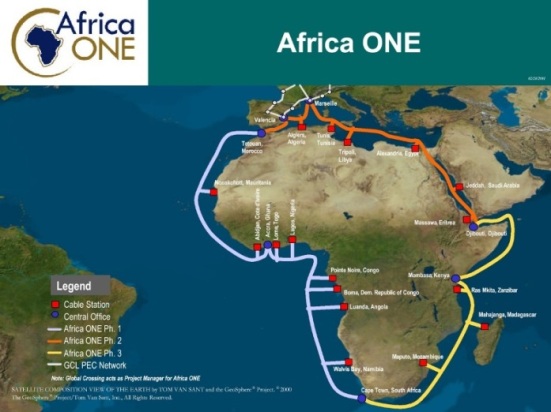Looking back: Africa ONE (intended to be Africa’s first fibre ring)
It [the consortium of owners] is a structure that works by consensus,” – Sizwe Nxasana, former CEO of Telkom SA
Nearly 12 years ago, Global Crossing announced plans to build a 39,000km, $1.6 billion fibre-optic cable around Africa. The project was slated to be completed in three years. However, for a variety of financial and political reasons, the project fizzled out – there are no media mentions of its failure. Years later, the WACS, EASSy, and EIG cover the same path with more cables on the way.
Why did Africa ONE never lay a single kilometer of fibre?
For one, the SAT-3 cable saw activation before Africa ONE. And, despite claims that around-the-continent Africa ONE performed better in terms of redundancy than a straight-line cable, there just wasn’t enough data flowing out of Africa to support such a lengthy cable loop. To further complicate matters was South Africa’s hesitation to join on. The last straw that contributed to the failure of Africa ONE had to do with the collapse of the global telecommunications industry. British Telecom, Lucent, and Cisco all faced major issues around the year 2001.
Apart from lack of financial backing, the Africa ONE project lacked qualities of a truly African renaissance. Despite interest from up to 30 African countries and the promise that the cable would be operated by Africa with profits to remain in Africa, the project only lost momentum as logistics became tangled among nations. In essence, the cable was just too long. Today’s focused cables like EASSy, WACS, and ACE are proving successful, in part because they do not encompass all of Africa.
Although the SAT-3/WASC/SAFE undersea cable (Europe-Africa-Asia) came in late and over budget in 2002, it still was cheaper than Africa ONE. Forty-six percent of the owning consortium is in the hands of African operators or governments. As such, they expected to reap both telecommunications and financial rewards over the cable’s 20-year lifetime.













 Twitter
Twitter Facebook
Facebook Pinterest
Pinterest
what i wonder is why send it via the sea when they could also link it over land as well linking multiple nations to each other with fiber to create multi-paths for network connectivity…. short-sighted ambitions.
I agree about the short-sighted ambitions. Undersea cables are
attractive when Africans are accessing most of their content from
international servers (as is the case now). Intra-African cables will
be an ideal long-term solution, but Africa needs local content so that the capacity doesn’t go wasted.